
Introduction
As one comes across the word “Sikh”, the heart automatically gets filled with respect and courage. Since the tenth and final Guru, Guru Govind Singh assumed leadership the Sikh community has come to be associated with fearlessness. In harsh circumstances, he came to stand for bravery, tenacity, and dedication. Not only Sikhs but millions of people around the world are still motivated by his life story and teachings today.
Early Life and Background
Guru Gobind Singh was born on December 22, 1666, A.D according to the Gregorian calendar in Patna Sahib, India (which’s now, in Bihar). According to Vikram Samvat it was Saptami of Shukla Paksha in Pausa Mash. His parents were Mata Gujri and Tegh Bahadur, who was the Guru of Sikhism, at that time. From an age Guru Gobind Singh displayed qualities of bravery and wisdom which would later shape his leadership. During his years he experienced both growth and personal loss.
When he was merely nine years old when his father Guru Tegh Bahadur sacrificed his life. His father sacrificed his life to defend Hindu rights and protect freedom from forced conversions. This impactful event fueled Guru Gobind Singh’s determination to fight against injustice and uphold the principles of Sikhism. Guided by his mother Mata Gujri he diligently. Embraced the teachings passed down by Sikh Gurus.
Rise to Leadership
Following the sacrifice of his father Guru Gobind Singh became the Sikh Guru when he was just nine years old. This happened during a turbulent period, in Sikh history. The Mughal Empire, which ruled over most of India at that time aimed to suppress freedom and enforce its beliefs. In response Guru Gobind Singh emerged as a leader who advocated for unity, resistance against oppression and the preservation of Sikh values.
One of the milestones under Guru Gobind Singh’s leadership was the establishment of the Khalsa community—a disciplined group of Sikhs. In 1699 he formed the Khalsa Brotherhood by initiating the ceremony. This represented a departure, from social divisions and hierarchies since Guru Gobind Singh proclaimed that every Sikh regardless of their caste or social status would be considered equal. The Khalsa became a symbol of courage, selflessness and an unwavering commitment to justice.
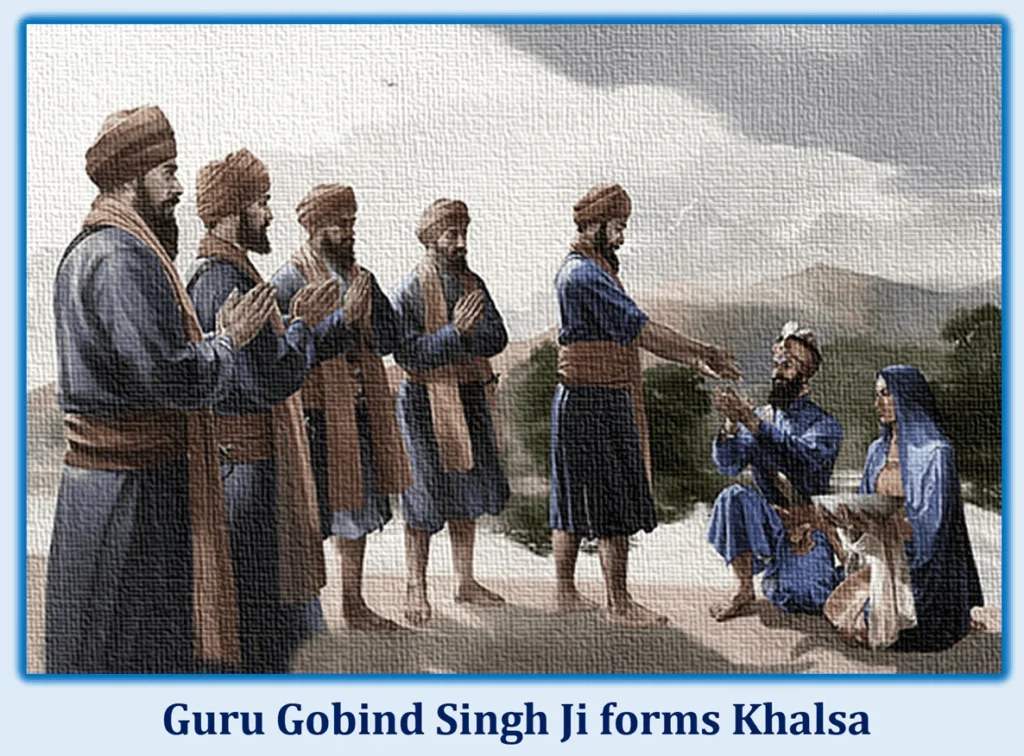
Significance of Guru Gobind Singh
Guru Gobind Singh holds significance due to his teachings and actions. He has had a great impact on Sikhism, as he shaped the religion in many ways. “Sant Sipahi” also known as the saint soldier was one of his major contributions to the religion. This idea fueled the Sikh community to grow stronger by aggressively opposing injustice and putting an end to tyranny. It finally paved the way for Sikh self-defense and statehood which evolved with time and resulted in the founding of the Sikh Empire under Maharaja Ranjit Singh.
Furthermore, Guru Gobind Singh played a role in safeguarding the status of Guru Granth Sahib, the scripture of Sikhs. He declared that after him the teachings within Guru Granth Sahib would serve as their guiding light. This unifying principle ensured continuity and integrity within Sikhism as a faith.
In addition to his leadership and spiritual contributions Guru Gobind Singh’s poetry and writings hold significance in Sikh literature. All his compositions contributed to the Guru Granth Sahib. The Sikhs’ holy text, the Guru Granth Sahib, is regarded as their source of inspiration and direction.
Guru Gobind Singh’s Teachings and Philosophy
Promotion of Equality and Brotherhood
Guru Gobind Singh firmly believed in dismantling hierarchies and promoting fairness among all individuals. He fearlessly opposed the caste system, a rooted structure that had long plagued Indian society. An egalitarian Sikh community was the result of Guru Gobind Singh’s vision. He rejected the complex caste system and urged the people to join the Sikh community for equality. By this courageous call, he sent a message to his followers urging them to treat everyone with dignity and respect regardless of their circumstances.
Moreover, Guru Gobind Singh empowered those who were marginalized by society by reaching out to them. He recognized the importance of those who were disadvantaged and urged them to turn to Sikhism for comfort and strength. Guru Gobind Singh promoted a sense of togetherness by welcoming individuals from all backgrounds. friendships among the Sikh people.
Additionally, Guru Gobind Singh placed emphasis on gender equality challenging the prevailing mindset. He defied norms by involving women in significant religious and political matters. By instilling empowerment in women Guru Gobind Singh reshaped their role, in society recognizing their abilities and importance. His teachings continue to impact Sikh women today inspiring them to shatter barriers and fearlessly pursue their dreams.
Defense of Sikh Values and Identity
To safeguard the Sikh faith, from influences and ensure its core principles remained intact Guru Gobind Singh implemented crucial measures.
Firstly he acknowledged the value of preserving Sikh scriptures. Recognizing the wisdom and spiritual essence contained within these texts Guru Gobind Singh compiled the Guru Granth Sahib—the religious scripture of Sikhism. This compilation unified the teachings of the Gurus. Ensured their preservation for generations. Sikhs residing in any part of the world consider Guru Granth Sahib as their source of inspiration and try to uphold the values and teachings of Guru Gobind Singh. In addition, Guru Gobind Singh founded the Khalsa group to protect the innocent and preserve Sikh principles.
The initiation ceremony known as Amrit Sanchar marked their entry into this order instilling a sense of identity and loyalty among its members. By creating the Khalsa Guru Gobind Singh fortified Sikhism against threats while fostering a spirit of bravery and righteousness within the Sikh community.
In addition to these efforts Guru Gobind Singh placed emphasis on what’re now known as the Five Sikh Beliefs or Five Ks—their importance was paramount in maintaining faithfulness, to Sikh traditions.
These symbolic elements, known as Kesh (hair) Kangha (a comb) Kara (a steel bracelet) Kachera (a particular undergarment) and Kirpan (a ceremonial sword) possess profound spiritual and cultural importance, within the Sikh community. Guru Gobind Singh encouraged Sikhs to embrace these symbols as a way to preserve their identity inspiring them to honor their heritage with pride.

Advocacy for Social Justice and Human Rights
Guru Gobind Singh’s philosophy went beyond Sikhism. Encompassed a vision of social justice and human rights. He passionately fought against oppression and injustice becoming a symbol of resistance and bravery. He encouraged his followers to stand up against all forms of injustice empowering them to strive for a society.
Additionally, Guru Gobind Singh strongly opposed forced conversions that were prevalent, during his time. He firmly believed in the right of individuals to choose and practice their religion. By condemning conversions, he advocated for tolerance and the significance of respecting others’ beliefs.
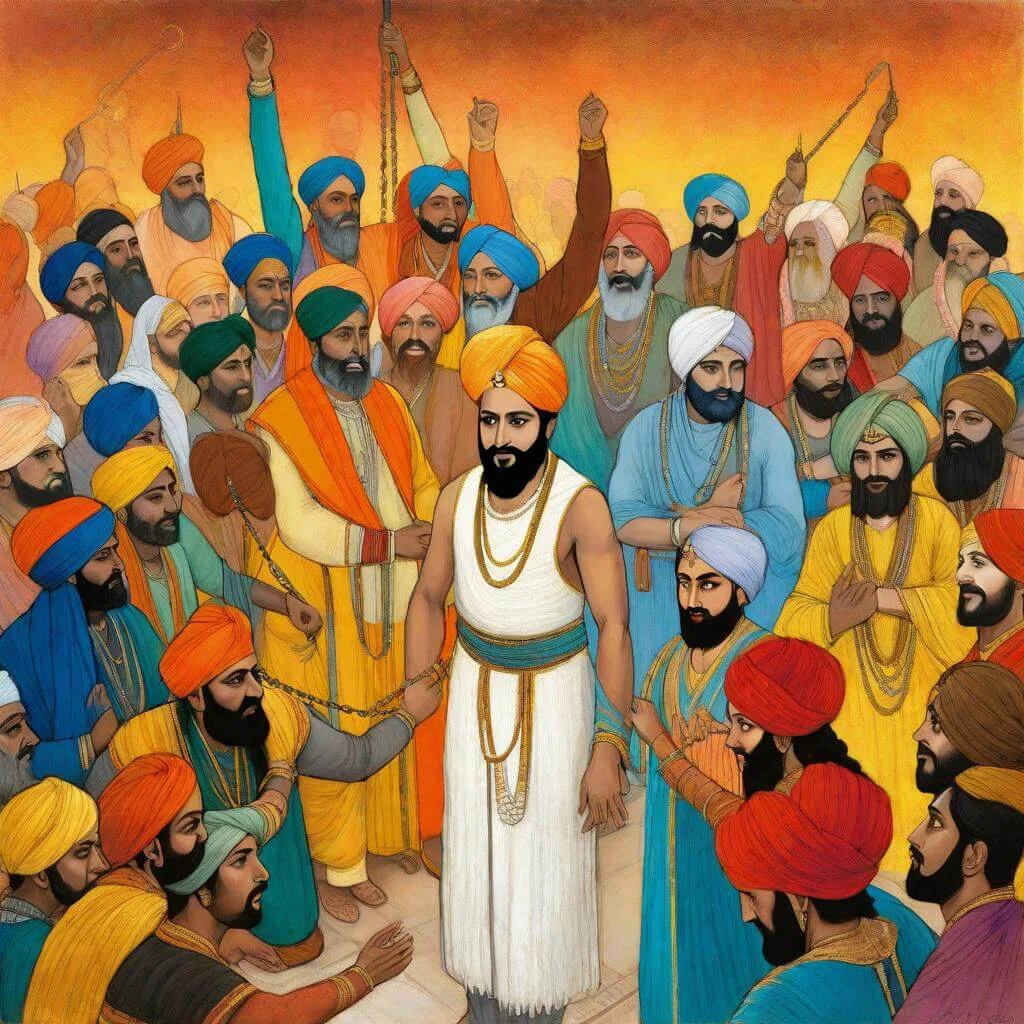
Moreover, Guru Gobind Singh was a proponent of freedom emphasizing that every person has the right to worship according to their own conscience. His vision was one where diverse religious belief peacefully coexisted. His teachings continue to guide Sikhs in embracing diversity and promoting interfaith dialogue.
“The most extraordinary thing about Guru Gobind Singh is the manner in which he welded his people into unity and made them into a fighting community; for that is what the word Khalsa means – and this was five years before 1776 when the people of the American colonies began their own revolution. I think the study of Sikh military history and of the continuing development of the Sikh community is more than a matter of academic reverence. It is one of the most important things for our time.”
– General Sir John Bagot Glubb
Guru Gobind Singh’s Military Leadership
Establishment of a Militant Force
Having felt the threat to the Sikh community and the need to safeguard them he took the responsibility upon him. This led to the formation of the Khalsa Army, a fighting unit comprised of devout and disciplined Sikh warriors. This endeavor not fostered a sense of pride and unity, among the Sikhs. Also served as a crucial defensive measure during challenging times.
Organization and Training of the Khalsa Army
Guru Gobind Singh meticulously laid out the structure of the Khalsa Army highlighting the significance of fitness, arts and weaponry proficiency. He implemented a training regimen that transformed individuals into highly skilled warriors. This emphasis on discipline and training established a foundation empowering the Khalsa Army to confront adversaries with confidence and bravery.
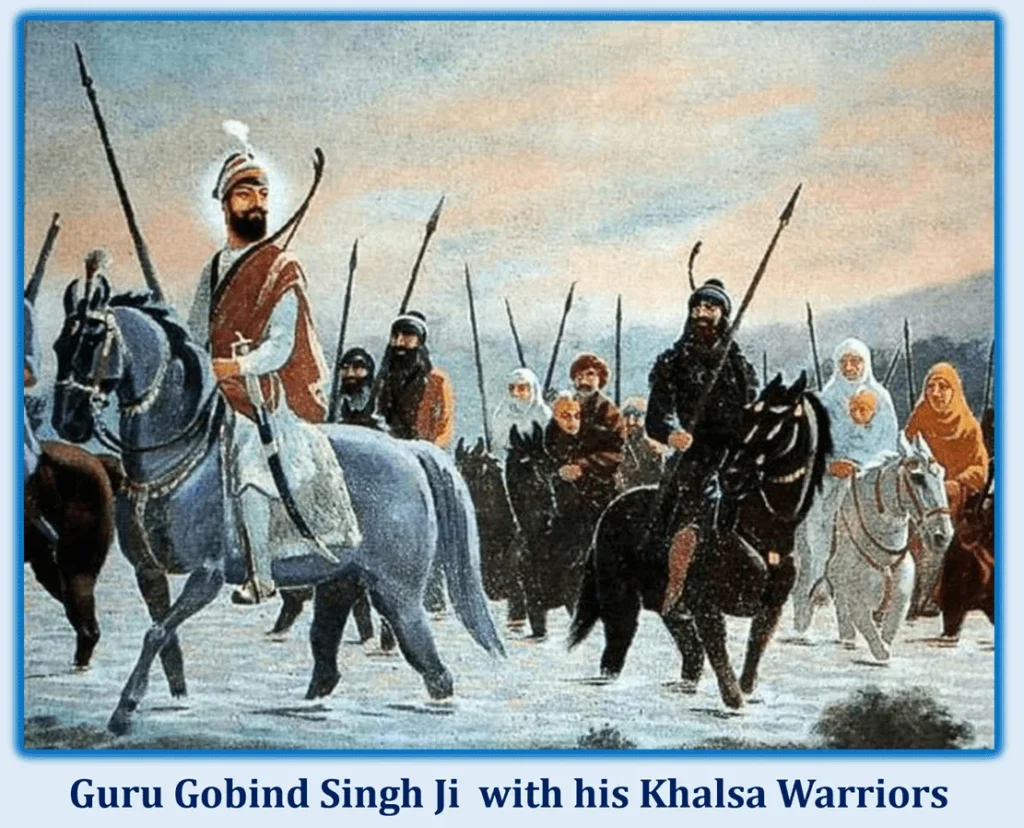
Development of Military Strategies
In addition to training Guru Gobind Singh devised military strategies that were ahead of their time. He recognized the importance of adaptability and employed guerrilla warfare tactics against the Mughal Empire. His incorporation of methods helped balance out disparities when facing dominant opponents.
Assertion of Sikh Sovereignty
Under Guru Gobind Singh’s guidance the Khalsa Army became a symbol representing Sikh autonomy and resistance against oppression. The Guru fought tirelessly for the rights of Sikhs. Stood up against the political authority of the Mughals. His relentless dedication served as an inspiration for Sikhs to unite against injustice and protect their faith ultimately resulting in the establishment of Sikh governance, in Punjab.
Defending Against External Threats
Guru Gobind Singh encountered challenges that posed threats to Sikhism. He fearlessly led his followers in battles, against adversaries employing tactics that played a crucial role in safeguarding the faith.
Engagements with the Mughals and Hill Chiefs
During Guru Gobind Singh’s era the mighty Mughal Empire posed a danger to Sikhism. However the Gurus military expertise was showcased in clashes like the Battle of Bhangani and the Battle of Muktsar, where the Khalsa Army successfully turned the tables against forces. Furthermore Guru Gobind Singh courageously. Triumphed over the threat posed by the Hill Chiefs ensuring security for the Sikh community.
Confrontations with Rajput’s and Afghans
Guru Gobind Singh faced challenges from both Rajput’s and Afghans who aimed to undermine Sikh sovereignty. The Gurus astute diplomatic skills enabled him to navigate these relationships. Through negotiations and alliances, he skillfully neutralized threats while steadfastly protecting Sikh interests.
Diplomatic Endeavors with Kingdoms
Beyond engaging in conflicts Guru Gobind Singh actively pursued diplomatic relations with various kingdoms to build strategic alliances. His efforts to forge connections with powers like Marathas proved instrumental, in securing Sikh interests and fortifying community resilience amidst pressures.
Sacrifices and Martyrdom
The personal sacrifices made by Guru Gobind Singh and the martyrdom of his followers truly exemplify his devotion, to Sikhism. The Gurus own experiences along with the dedication shown by his followers have become moments that shape Sikh identity and serve as an inspiration for generations.
The Sacrifice of Chaar Sahibzaade at the Chamkaur Battle
The Battle of Chamkaur fought for three days from December 21-23,1704 (some sources mentions the year to be 1705) , is a crucial part of Guru Gobind Singh life. He along with his small group of warriors displayed an exemplary bravery on the battlefield. Despite being less in number against the combined forces of the Mughals under the leadership of Wazir Khan and some of Hindu chief of the hill, they fought bravely. Many of the Sikh warriors sacrificed their lives just to defend their religion. Among the martyrs were the Chaar Sahibzaade, the sons of Guru Gobind Singh. Sahibzade Baba Ajit Singh and later Baba Jujhar Singh sacrificed their lives fighting fearlessly with the enemies. Further, Baba Zorawar Singh Ji and Baba Fateh Singh Ji were captured and produced before the Nawab Wajir Khan. They were asked to adopt Islam and were lured prestigious position in the Mughal Court to save their lives. But the Sahibzaade’s choose to sacrifice their life and were later sealed alive in the wall.
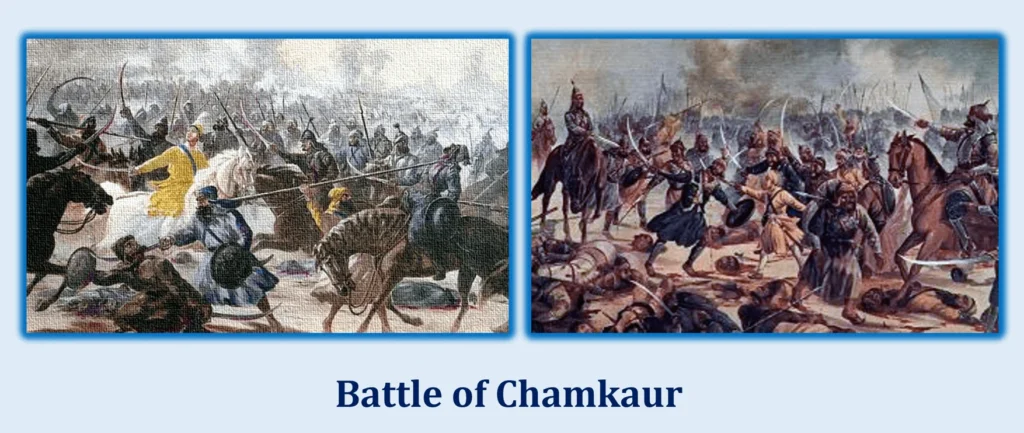
The Valiant Heritage of Guru Gobind Singh
Guru Gobind Singh established an incredible impact which has influenced Sikh history through his courage and determination in the face of difficulties. He saw martyrdom as a way to uphold honor. encouraged his adherents to maintain their faith. Sikhs are still moved by his unshakable dedication to equality and justice.
Honoring the Martyrs
Not only Sikhs but all the admirers of Sikhism remember the sacrifices made by Guru Gobind Singh and his followers through practices. On the occasion of Guru Gobind Singh Jayanti, which marks the Guru’s birth anniversary, we have the opportunity to reflect on his teachings, pay tribute to those who sacrificed their lives, and reaffirm their commitment to Sikh ideals.
Guru Gobind Singh’s Literature and Legacy
The writings of Guru Gobind Singh are a testament, to his vision and spiritual wisdom. His literary works serve as an inspiration and guidance, for generations of Sikhs.
Creation of Sacred Scriptures
Compilation of the Dasam Granth
One of Guru Gobind Singh’s achievements was the gathering of the Dasam Granth, a scripture held dear in Sikhism. This compilation consists of a variety of hymns, religious poetry and narratives. The Dasam Granth serves as a source of guidance and moral teachings, for Sikhs worldwide.
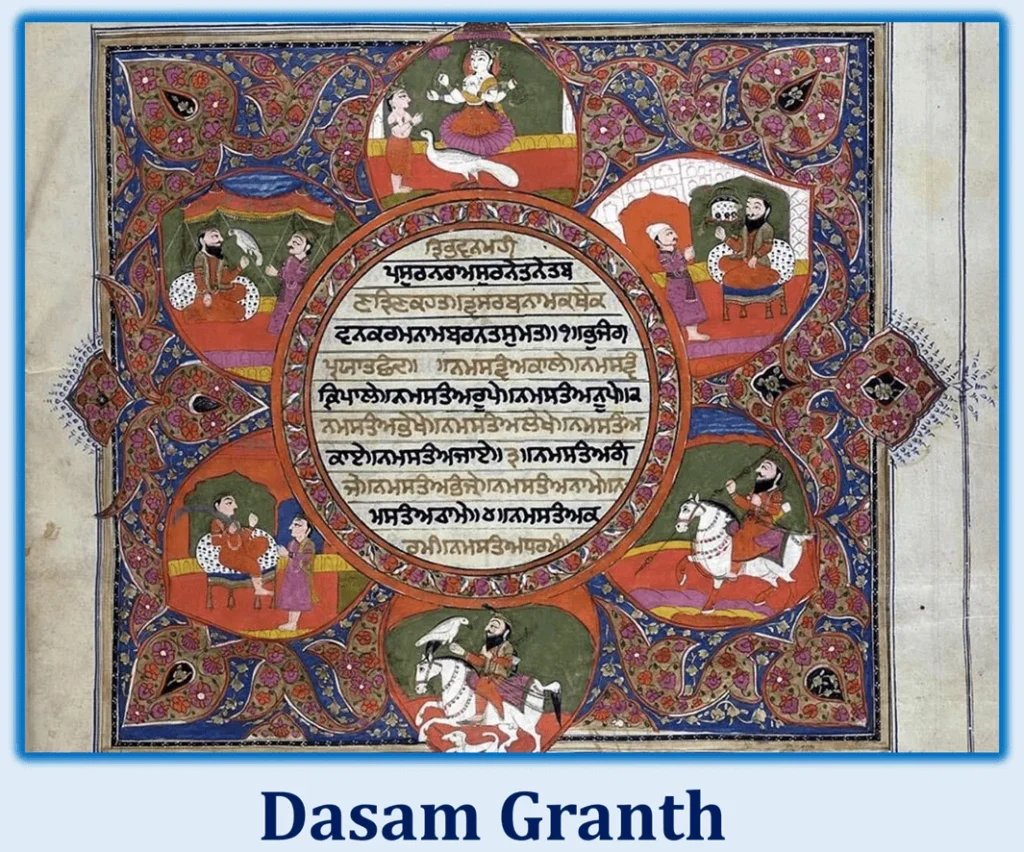
Poems and Hymns
Guru Gobind Singh, renowned for his talent composed captivating poems and hymns. His exquisite poetry often portrayed themes, courage and the pursuit of truth. These verses continue to resonate with Sikhs today inspiring them to deepen their connection with their faith.
Literary Contributions
In addition to the Dasam Granth and his poetry Guru Gobind Singh made contributions to other forms of literature. He wrote accounts, philosophical treaties and letters that addressed issues during his time. His literary legacy not Sikhism but also played a role, in shaping the wider literary landscape.
Influence on Sikh Culture and Identity
The influence of Guru Gobind Singh goes beyond literature. Has greatly shaped Sikh culture and identity. Lets delve into how his teachings and actions have impacted Sikh traditions and heritage.
Impact on Sikh Art and Architecture
Under the leadership of Guru Gobind Singh, Sikh art and architecture flourished. The remarkable skill showcased in Gurdwaras which’re the Sikh places of worship is a testament, to his guidance. These holy spaces are adorned with designs, vivid colors and symbolic patterns that enrich the journey, for worshippers.
Celebrations and Festivals
Guru Gobind Singh introduced celebrations and festivals that hold significance in Sikh culture. Among these Vaisakhi stands out as it commemorates the formation of the Khalsa, which represents the community of initiated Sikhs. These joyous festivities serve as a force fostering a sense of unity and pride among Sikhs worldwide.
Preservation and Promotion of Sikh Heritage
Guru Gobind Singh’s dedication to preserving Sikh heritage has left an impact. The establishment of the Khalsa warrior community by him emphasized values, like courage, discipline and righteousness within Sikhs. Today numerous Sikh organizations and individuals actively work towards safeguarding and promoting their legacy to ensure that future generations fully embrace it.
Contemporary Relevance and Global Impact
Guru Gobind Singh’s teachings and life lessons remain significant in todays world. Let us explore the impact he has on the Sikh community the leadership lessons he imparts and the message he conveys for humanity, in our modern era.
Influence on the Global Sikh Community
Guru Gobind Singh’s teachings have deeply influenced Sikhs across nations. His principles of equality, justice and selfless service have inspired Sikhs worldwide to make contributions to their communities. The global Sikh community stays united through their shared beliefs and dedication to Guru Gobind Singh’s teachings.
Valuable Lessons in Leadership
The life of Guru Gobind Singh serves as an example of leadership. His unwavering courage, resilience and commitment to justice offer insights for individuals in positions of authority. Sikh leaders and entrepreneurs often draw inspiration from his teachings to create an impact within their domains.
Guru Gobind Singh’s Message, for Todays Humanity
In our day world Guru Gobind Singh’s message of inclusivity, tolerance and social justice holds immense relevance. His teachings encourage individuals to transcend prejudice and embrace diversity.
“Guru Gobind Singh fearlessly led the Sikhs in embracing their beliefs and standing up for their principles. His teachings continue to provide guidance and inspiration to generations urging us to exhibit courage, compassion and a steadfast commitment, to justice.”
Summary & FAQs
Guru Gobind Singh contributed to the revival and vitality of the religion. His extraordinary existence was defined by achievements that Sikhs find very moving even now. The Sikh community’s perception of respect and importance has been established by the priceless contributions and everlasting impact of Guru Gobind Singh.
An overview of life of Guru Gobind Singh
Guru Gobind Singh, who was born in 1666 succeeded his father, Guru Tegh Bahadur. He went on to become the tenth Sikh Guru when he was just nine years old. In spite of obstacles, Guru Gobind Singh became a visionary leader.
One of his accomplishments was establishing the Khalsa—a revered order comprised of baptized Sikhs. This bold step transformed Sikhism from being a path to embracing both saintly virtues and a warrior spirit within its followers. Guru Gobind Singh’s vision for the Khalsa inspired Sikhs to stand up against injustice and protect those, in need.
Lasting Influence and Contributions
Guru Gobind Singh’s contributions extended beyond reforms; he also made advancements in military strategies, literature and cultural domains.
In order to bring together the Sikh community and give them a sense of belonging he introduced five items known as the emblems of the Khalsa. These include hair (Kes), a comb (Kangha) ,a steel bracelet (Kara), an undergarment (Kachera) and a ceremonial sword (Kirpan).
Under the leadership of Guru Gobind Singh the Sikhs gained prowess. He established a organization and provided warfare training to his followers. As a result the Khalsa became a force. Played a crucial role, in resisting Mughal oppression while upholding the values of Sikhism.
Apart from his achievements Guru Gobind Singh was also a writer and poet. He composed chants, hymns. Authored the Dasam Granth—a compilation of religious texts. His literary contributions not only enriched the Sikh scriptures but also offered spiritual guidance to his devoted disciples.
Continuing Reverence and Importance
Furthermore Guru Gobind Singh’s teachings and legacy continue to shape Sikh identity and influence their practices. His focus on justice, equality, and selflessness was an important aspect of Sikhism. His convictions to reject discrimination on the basis of caste, creed, or gender, and promoted inclusivity, reinforced the bonds of the Sikh community.
Guru Gobind Singh is admired for his teachings on bravery, charity, and moral dedication. It crosses the religious divides and promotes respect among individuals. Moreover, anybody seeking to lead a virtuous life his teachings offer hope and light.
Frequently Asked Questions (FAQs)
Who succeeded Guru Govind Singh as the next Guru?
Guru Gobind Singh designated the Guru Granth Sahib to be the Sikhs’ future guru in 1708. He urged his disciples to consult it for guidance. The Guru Granth Sahib is considered as the living spiritual successor of Guru Gobind Singh and a storehouse of knowledge.
How important are the Five K’s?
In Sikhism, the Five K’s are significant. They stand for the Sikh people’s unwavering dedication to preserving the core beliefs of their religion. The uncut hair (Kes) represents acceptance of Gods will and natural form while the comb (Kangha) signifies cleanliness and discipline. The steel bracelet (Kara) serves as a reminder to follow a path the undergarment (Kachera) represents self-restraint and the ceremonial sword (Kirpan) symbolizes duty in protecting and upholding justice for those who’re vulnerable.
How did Guru Gobind Singh’s teachings influence Sikh identity?
Guru Gobind Singh’s teachings played a role in shaping Sikh identity. His emphasis, on pursuing knowledge promoting equality engaging in community service and standing against injustice helped establish a Sikh identity. His teachings serve as a source of inspiration, for Sikhs motivating them to lead a life that’s both ethical and meaningful. His teachings also emphasize the values of unity, equality and justice.
